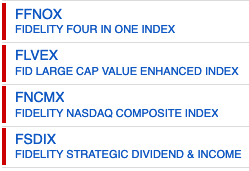Oh goody! Please let this be another article from a self-proclaimed “expert”, blathering on about long-term plans and investing wisely.
It is not, to be clear. You are safe here.
So what the hell am I going to talk about? Why, it is indeed about investing, and probably wisely, and definitely with the long-term in mind. But I am not an expert. There’s the difference, I suppose.
![]() My employer migrated our 401ks to Fidelity. I poked around in there for a while, using their retirement score projection algorithm to make some adjustments both to my investment strategy and my contributions. It was really riveting stuff, but necessary if I ever want to leave cubicle life. Then they gifted me some restricted stock units (stock I don’t get until I add another 2 years to my tenure), which got me interested in exploring Fidelity’s full site, and not just the dumbed-down version the company maintains for retirement snapshots. And I admit, it looked cool, in the way a well-designed spreadsheet of data does.
My employer migrated our 401ks to Fidelity. I poked around in there for a while, using their retirement score projection algorithm to make some adjustments both to my investment strategy and my contributions. It was really riveting stuff, but necessary if I ever want to leave cubicle life. Then they gifted me some restricted stock units (stock I don’t get until I add another 2 years to my tenure), which got me interested in exploring Fidelity’s full site, and not just the dumbed-down version the company maintains for retirement snapshots. And I admit, it looked cool, in the way a well-designed spreadsheet of data does.
I had never consciously invested for a variety of reasons:
- I never had the liquid assets to buy stock shares
- I knew very little about how the stock market works
- I was afraid
- It looked like a lot of work
But then I heard of Index Funds. Well, I had heard of them before but never gave them much thought. Their mention tended to pop up on podcasts and news segments, so the seed had been planted well before I seriously considered buying them outright (I don’t consider my 401k to be that granular–though it technically is investing in index funds under special tax benefits, albeit about as hands-off as you can get).
And after some rather very basic research, discovered that:
- Many of them required no minimum investment and have very small fees
- I didn’t need to know much to benefit from them
- Risk could be mitigated with preference–how safe an index I was willing to buy
- The investment strategy for them is passively managed and I could auto-invest, requiring almost no effort on my part
Okay, sounded kind of fun. I searched for Fidelity-owned index funds that matched these qualifiers. I decided to “diversify” with 3 of them, ultimately choosing 4 so I could have a dividend-paying index to add to the mix:

I linked my savings account for EFTs and bought $10 of each, then configured their auto-invest feature to automatically perform an EFT and buy $10 for each one on a rotating weekly basis. I was an official investor!
Then COVID-19 struck and I subsequently lost 17% of my investments. Ah well, I suppose they’ll go up again eventually (I won’t even mention what it’s done to my 401k!).

But stocks are up today! I might make a buck or two back! Time will tell how well this works over the long term. And I now have one more old man hobby to occupy my hours of solitude in the basement.
Liz has threatened to tell her father I’m investing so we have something to talk about.
Oh god.
–Simon
